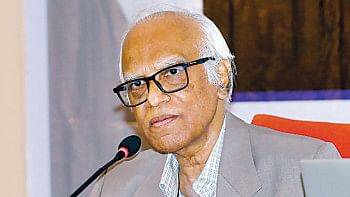Is It Truth or Dare?

Those familiar with Nadia Kabir Barb's column Straight Talk in The Daily Star will be pleased with her short fiction debut Truth or Dare. Published by Bengal Lights Books in 2017, this anthology of twelve stories takes readers on an intimate journey across two cities, Dhaka and London, with characters that are richly drawn and varied.
A British Bangladeshi author, Barb draws inspiration from her multicultural background. The articles of her newspaper column had delved into social-political issues as well as common everyday occurrences. The stories of her debut collection too teem with themes as diverse as love, betrayal, friendship, loss, midlife crisis, failed marriages, broken families, choices made and soul-gazing.
A number of Barb's stories focus on intimate aspect of relationships. "Can You See Me?" brings together two people who are quite dissimilar and yet quite alike on London Bridge in a cool night. The nineteen-year-old Alexander Ahmed, sans home or a job, meets Nina, on the verge of ending her life, and the two ends up with an unusual friendship, sharing their woes and worries. Raju and Tareq, the two friends of "Truth or Dare," embark on a thrilling game of truth or dare while confronting their innermost fears.
Relationships are thus etched in different shades in Barb's stories. The third story of the collection, "Inside the Birdcage" takes us to the domestic sphere where Shabana, shabbily treated by her in-laws, keeps her miscarriage a secret. For most of the story, her husband, Anwar remains aloof from his wife's miseries. Only in the end does he turn into a different person, surprising both his wife and mother thereby.
"In Case I Die" and "Let me Go," two interesting stories, share the same undercurrent theme of death. The woman in "In Case I Die," in and out of here senses after a stroke, realizes that "there is never a right time to die." With the children still young and a bucket of wish list yet unfulfilled, she wants to scream out: "I am not ready, I am not ready." Barb allows readers access to the mind of the woman by using the stream of consciousness technique. "Let me Go" has a similar theme where a man lies unconscious while the wife waits patiently by his hospital bed, not for his recovery, but for release from a long, unhappy married life. Reminding us of Kate Chopin's famous work "The Story of an Hour," the second story stages the final scene of a drama that began a long ago. Strangely enough, the titles of these two stories echo each other, as if one was the answer to the query posed in the other one.
The themes of loss and longings appear in a couple of stories. Maya in "The Descent" cannot come to terms with life after the loss of her husband, Yusuf. This story, however, seems somewhat out of place in the collection as it has the feel of a thriller where a murderer returns for revenge. The crippled beggar Manik in "In the Lives of Others" despairs at the end of a promising life while watching people queue up in front of the American Embassy where the American dream is being sold in the form of visas. "The Enlightenment of Rahim Baksh" recounts the story of a protagonist caught in a midlife crisis, full of lustful longings and looking for a fling. Romance does swirl up in his life but his hopes are dashed; Rahim is in the end back to a mundane existence and his boring wife.
Homelessness is a common theme in both the first and last story of the collection and one wonders if this arrangement was a deliberate one. Barb depicts the human condition in them through portraying afflicted people in both the east and the west. While Alexander Ahmed in the first story "Can You See Me," is a homeless boy in London who drifts from one place to another in search of a comfortable night's stay, Manik, the central character of the concluding story "In the Lives of Others" is seen lying in a Dhaka street after a fatal accident.
While a few stories portray stereotypical images of Bengali housewives and women, a few others manage to focus on more untypical situations. A lesbian relationship, still a taboo in the east, is presented well in one of the stories. Barb, indeed, doesn't try to give sugar-coated, concocted picture of lives in the west. Murders, separations and disintegration of families in the west are depicted in stories such as "The Descent," "My Father's Daughter," and "Don't Shoot the Messenger."
Nadia Kabir Barb's stories are mostly amusing and often unpredictable. Readers in both the east and the west will surely find t hem enjoyable. Just as the picture of life in the west is present here for Bengali readers, a slice of Bangladeshi life is on offer here for western readers as well. Barb's honest attempt at giving us glimpses of both these worlds should thus be applauded. She has done a commendable job in this debut collection and one hopes she will keep offering such noteworthy fiction in the future as well.
Marzia Rahman is a translator and fiction writer based in Dhaka.


 For all latest news, follow The Daily Star's Google News channel.
For all latest news, follow The Daily Star's Google News channel. 



Comments